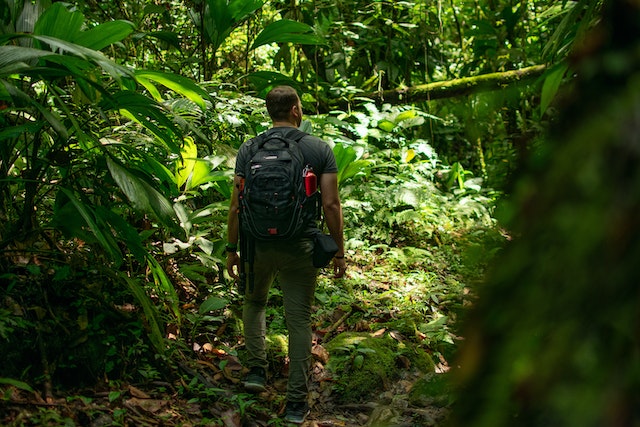
What is a jungle? It is generally an area of dense forest in a tropical climate.
Many people think a rainforest is a jungle but they are different because a rainforest is a specific ecosystem, and a jungle is a description of an overgrown and tangled forest. The word “jungle” has come into English from Sanskrit. Its origin is janagala-s, which meant rough and arid, seemingly the exact opposite of the meaning of the modern word jungle. In Hindi, jangaal meant any uncultivated land, so wastelands, deserts, and forests. The word came into English and by 1776 it was only used to refer to “a dense growth of trees and other tangled vegetation.”
Rainforests and jungles do have some similarities. They are both found in warm areas with high amounts of rainfall. This keeps them lush and the flora and fauna grow very fast and very big. However, jungles are very dense areas, very overgrown, and full of vegetation that is tangled. If you want to get through a jungle, you are probably going to need a machete. Rainforests, on the other hand, are very sparse on the ground. This is because the trees grow tall, often 30 m, and form a thick canopy overhead that blocks out all of the sunlight. Very few things can grow on the floor of the rainforest and there is a lot of space between the trees. If you walk through a rainforest, you will need a flashlight more than a machete.
Another reason jungles and rainforests are often confused is because jungles can grow on the edges of rainforests, along rivers, or in other open spaces. The tree canopy prevents things growing on the floor of the rainforest, except where there is no tree canopy. Along the edges of the rainforest and along rivers, the tree canopy is removed, and the sunlight causes things to grow. The edges of rainforests will be very thick with vegetation, and you’d need to cut through until the tree canopy cuts out the sunlight. In places where storms or hurricanes have knocked trees down there will be jungle as well. As we cut down the rainforests, either for logging or to graze animals, we are actually making more jungle because we are removing the tree canopy.
Early explorers usually entered the rainforests along the rivers, and all they could see was jungle, which led them to believe that all of the rainforest was jungle. Many of them believed there was no way through, something they would have found to be wrong if they had cut far enough in. Because the explorers started to talk about this impenetrable jungle, the word has stuck in the public consciousness.
The plants in the jungle grow extremely quickly because the soil is usually a clay soil with a lot of nutrients and the weather is very hot and humid. These are the perfect conditions for plant growth. Some trees release chemicals from their roots to keep plants away from them, but this doesn’t happen in the jungles and the undergrowth can grow fast and very close to each other. This means they end up very tangled. They have adapted to this, and they have many different ways of dispersing their seeds. A lot of them rely on the many animals and insects that live in jungles. Typical plants that grow in jungles are mosses, algae, fungi, banana trees, and grasses.
More plants and animals live in jungles than in rainforests. Well, that is to say, they live on the edges of the rainforests and along the rivers and in clearings. That makes sense because there is more sunlight there and the majority of animals move and hunt in daylight. There is also a lot more undergrowth in the jungle that animals can eat. It can be hard to find food in a rainforest because there is so little that grows on the ground. They also need to live near a water source because most of the rain that falls on the rainforest never reaches the ground. The animals that are most adapted to rainforests live in or above the tree canopy. It is estimated that 3.5 km2 of jungle can have 50,000 insect species living in it. Far more small species of animals live in jungles than in forests and rainforests because it is so dense that larger animals would become trapped. Lions, for example, despite being called the King of the Jungle, don’t actually live in a jungle. They can’t. They live on the savannah, where it is open. And this is what I learned today.
Photo by juan mendez: https://www.pexels.com/photo/man-carrying-black-backpack-standing-beside-trees-3076431/
Sources
https://getproofed.com.au/writing-tips/7-english-words-with-origins-in-sanskrit/
https://www.etymonline.com/word/jungle
https://www.nationalgeographic.com/environment/article/rain-forests
https://rainforests.mongabay.com/05-rainforest-floor.html
https://en.wikipedia.org/wiki/Jungle
https://www.thedailyeco.com/what-are-jungle-ecosystems-93.html
